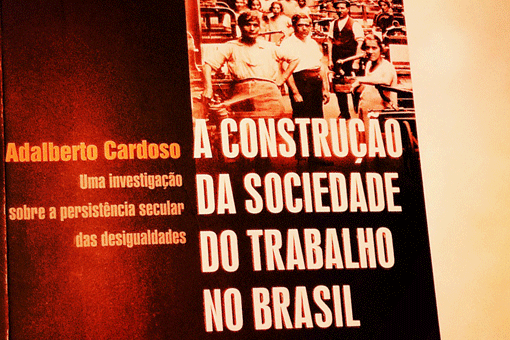According to the Brazilian Institute for Geography and Statistics, half of Brazil’s estimated 60 million poor have entered the lower middle class in recent years. But the country still faces the daunting task of sustaining this trend and overcoming deeply rooted social and economic injustice.
This challenge is brought into sharp focus in Adalberto Moreira Cardoso’s A construção da sociedade do trabalho no Brasil: uma investigação sobre a persistência secular das desigualdades (Building the Workforce in Brazil: An Investigation on the Persistence of Inequalities). Cardoso, a professor and researcher of the sociology of labor at the State University of Rio de Janeiro, investigates the persistence of centuries of inequality in a society only founded on slave labor and that was late to industrialize. This well-written book offers an unvarnished view of the heavy legacy left by what the author describes as the “anti-social state” built by the oligarchies that have ruled on the basis of slave labor for almost four centuries. In Cardoso’s view, the legacy of slavery shaped the structure of the Brazilian capitalist state, which did not create mechanisms for social protection until the 1930s. This meant the state became the engine of “reproduction of hierarchies and social inequalities.”
The book’s central argument is that the country’s unequal social and economic order is accepted by most Brazilians. This, the book suggests, may partly explain the relative absence of political violence.
The author, who is also affiliated with the University of Warwick Institute for Employment Research, summarizes his analysis in the seventh and final chapter, which focuses on concepts of justice and perceptions of inequalities. Cardoso concludes that the persistence of inequality in Brazil, “although perfectly visible to Brazilians…is seen as legitimate by the immense majority of them and, especially, by the poorest.” The conclusion may shock foreigners but is widely accepted by Brazilians themselves.
In earlier sections of the book, the author offers some equally shocking findings that lead him to declare that Brazil suffers from the absence of a “clear standard” that both rich and poor can use to make practical judgments about the fairness of the distribution of wealth and opportunities. His findings are based on an analysis of a 10-year, multicountry comparative survey by the International Social Survey Program (ISSP) that looks at concepts such as economic necessity and opportunity, capacity and merit, and social justice. He focuses on three cases: Sweden, a welfare state where poverty has been eliminated; Germany, which follows a more hierarchical and corporatist model in determining eligibility for positions in the social structure; and Poland, a country that is similar to Brazil in regard to its per capita income, period of democratization (1980s) and implementation of neoliberal economic reforms.
Unlike their counterparts in these three countries, Brazil’s rich and poor largely focus on opportunities for social mobility based on what they perceive to be their own situations. “Surprisingly,” Cardoso writes, “[in Brazil] the rich are more inclined than the poor to judge as unjust the greater access they have to health and education.”
In contrast, “the poor are much less inclined to make such types of judgments about injustice.” This, he writes, “is disconcerting, since the poor consider their income to be dramatically inferior to what is just or deserved.” According to the author, the ISSP survey reports that about three-fourths of the poor say that their situation remained equal or worsened between 1997 and 2007, while 66 percent of the rich described their situation as the same or improved.
Cardoso traces the roots of the poor’s conformist attitude and their “appalling low level of [social] aspiration” to the longevity, brutality and predatory character of slavery in Brazil. Slavery not only destroyed lives and depersonalized the captives, but also distorted the very notion of work, which was seen as punishment and an undignified activity for non-slaves. Only decades after the formal abolition of slavery in 1888 did Brazilian society overcome such attitudes.
But workers themselves remained undervalued. It took 30 years to enact measures for worker protection after the 1889 proclamation of the Republic of the United States of Brazil. “For the Brazilian agrarian elite, economic liberalism meant only that the state would not interfere in the way they managed their business and, particularly, their work force,” the author writes.
In the 1930s, at the beginning of the country’s industrialization and rapid urbanization, a revolution led by Getúlio Vargas finally introduced social rights for workers. Nevertheless, Vargas feared that urbanization would not be accompanied by the creation of manufacturing jobs, but rather by a rural-to-urban migration of peasants that would only worsen inequality. Cardoso argues that Vargas’ project “would become a powerful instrument of transmission of social inequalities.”
It will be interesting to measure over the next few years whether and how perceptions of social justice have been effected by the distributive social policies aggressively implemented during the eight-year administration of former President Luiz Inácio Lula da Silva, the first “man of the people” to reach the presidency.
The poverty reduction and social and economic advances achieved during the Lula administration give Brazilians reasons to believe that they will benefit. It remains to be seen whether this moment of transformation will be potent enough to liberate Brazil’s workers from the repression of social aspiration that prevailed through most of their country’s history and remains an obstacle for a still very unequal society to fulfill the promise of inclusion.





